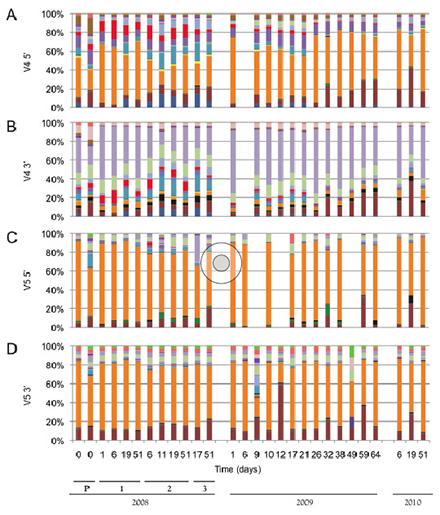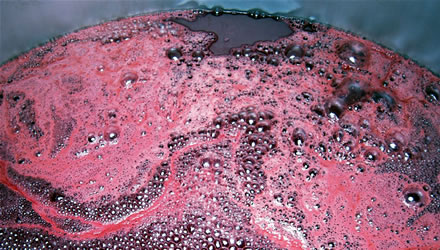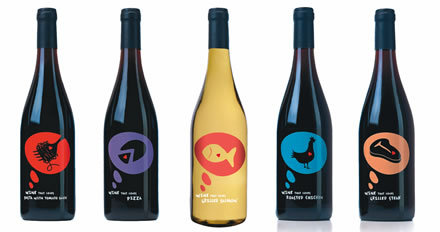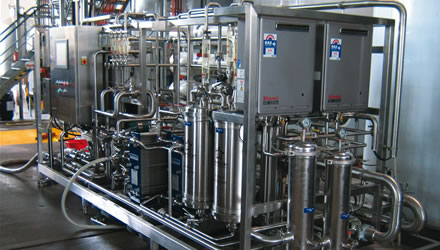
Inquiring Winemaker
by Tim PattersonInquiring Winemaker
May 2014In Search of Grapevines and Terroir
WARNING: This column, normally about winemaking topics, is entirely devoted to grapegrowing. Worse, it makes fun of several long-cherished beliefs about grapes and their contribution to wine. But at least I do quote Glenn McGourty, another writer for this magazine and someone who actually does know a lot about grapes, to help with the demolition.
The reason for straying from the wonders of enology is that I am working on a book about terroir (what wine writer isn’t?). The idea is to include between one set of covers reprints and excerpts from all manner of folks, coming from all manner of angles, from romantic wine writers to soil scientists, from sensory analysts to marketeers. The aim of the collection is to defend the concept of terroir by clearing out the vast acreage of pre- and non-scientific underbrush that has grown up around it. (Things like the idea you can literally taste the vineyard soil in your glass.)
One long chapter will be devoted to viticulture, which, weirdly enough, is largely absent from traditional terroir discussions, which focus on soil, maybe climate, and the imperative for winemakers to do as little as possible. What passes for viticultural wisdom in the old-fashioned terroir mindset is a series of platitudes about grapevines, mainly about aspects of grapegrowing outside human control. Vines need deep roots (which they grow themselves) to express terroir; vines need to be dry farmed (with whatever rainfall happens to show up); vines have to be old (while you sit and wait), and so on. There is a lot of fatalism in this version of grapegrowing; terroir just happens in special places, and the rocks get the credit.
In fact, grapevines are not simply passive transmitters of earthly essences. This is a pre-scientific notion that leaves out the defining role of photosynthesis, the engine of plant growth and energy, the force behind flowering and fruiting and ripening and the manufacture of aromatic and flavor compounds and precursors inside of grape berries.
Ask the experts
READ MORE »
Inquiring Winemaker
April 2014Will Barrels Go the Way of Floppy Disks?
Comparisons, sometimes heated, between making wine with oak barrels and making wine with various barrel alternatives—oak staves, micro-ox, etc.—have been thrown around for a couple of decades now. While much disagreement is still abroad in the land, a number of things have been definitively established, and it’s useful to draw up the balance sheets for both sides.
READ MORE »
Inquiring Winemaker
March 2014Do You Know What's Inside Your Barrel?
Split up the harvest of a small vineyard among five boutique wineries, do the winemaking in all cases along similar lines, and no one will be surprised when the results in the bottle all taste and smell noticeably different. But open up five barrels from the same cooperage, with the same toast level, and your jaw may drop at the variation on display.
READ MORE »
Inquiring Winemaker
February 2014The Downside of a Cleaner, Gentler Crush Pad
In winemaking, as in so much of life, it’s possible to have too much of a good thing. A bumper crop in the vineyard is great, but over-cropped vines make lousy wine. Warmth is a fine thing for fermenting and extracting red grapes, but crank that must up to 110º F and your Petit Verdot will get deep-fried. Integrated oak is a good thing; egregious oak is a bad thing.READ MORE »
Inquiring Winemaker
January 2014Winemakers Rely on Living Equipment
What’s the most important piece of equipment in any winery?
Most of the gear buzz in the past few years has been about the nexus of sorting, destemming and (barely if at all) crushing: The quest for perfect, squeaky clean, absolutely intact berries at the start of fermentation. The choice of cooperages and toast levels in a barrel program can make or break a wine. Membranes do magical things. Flash Détente may save the world.
READ MORE »
Inquiring Winemaker
December 2013Why Winemakers Don't Dare Touch pH
The marketplace for wine technologies, additives and services features its fair share of “solutions” to problems winemakers don’t really have. If you believe all the brochures, most every grape is nutrient-deficient and color-shy, sorely in need of enzymatic assistance or vinous mustard plasters, and headed for a final alcohol level that could always be made better with a quick journey through reverse osmosis. But this month’s sermon is about a different mismatch: a problem that truly does exist, and for which solutions demonstrably work—but hardly anyone bothers to use them.READ MORE »
Inquiring Winemaker
November 2013The Sticky Side of Tannin Management
Top researchers from around the world gathered at an all-day Tannin Symposium held in conjunction with the annual meeting of the American Society for Enology and Viticulture in June. But the biggest tannin buzz came from another presentation given the day before, one that was generating reference after reference in subsequent panels. I’m not sure enologists make much use of Twitter to air what’s on their minds, but if they did, this paper would surely have been trending, with the hashtag #hybridtannin.READ MORE »
Inquiring Winemaker
October 2013The Skinny on Skin Contact for Whites
Some aspects of commercial winemaking, as Donald Rumsfeld might observe, are known-unknowns. We know, for example, that a lot of wineries use Velcorin to sterilize their wines, but we have no idea how many or how often, since neither winemakers nor the supplier will talk about it in public.READ MORE »
Inquiring Winemaker
September 2013Good Vintners Keep Wine Writers Honest
I will never forget the day I spent blending wines with Steve Pessagno.READ MORE »
Inquiring Winemaker
July 2013Do You Know What's In That Bottle?
Which of the following would offer a more helpful description of a wine you were curious about?Bacterial community structure determined by sequencing of the V4 (Panels A,B) and V5 (Panels C,D) domain of 16S rRNA.2READ MORE »
Inquiring Winemaker
June 2013Lessons Learned the Hard Way
If you exclude my one-year internship stint, 2012 marked my 30th harvest as a winemaker. I don’t have to tell my winemaking colleagues that this is the one profession that makes your non-winemaking friends envious. You are never bored, you make decisions on the spot every day, you drink great wines and eat well, you’re always learning something, and you meet the most interesting people—many of whom become good friends.READ MORE »
Inquiring Winemaker
April 2013Can Brettanomyces Be Managed?
Editor’s note: Tim Patterson is on temporary leave from writing the Inquiring Winemaker column while he works on his next book. Winemaking researchers, teachers and professional winemakers will be contributing to this page during his absence.READ MORE »
Inquiring Winemaker
February 2013Finding Balance in Viognier
Today’s consumers expect Viognier to be well balanced with a symphony of integrated aromas and flavors. Balance and harmony are two descriptors often used to denote quality, while unpleasant coarseness, aftertaste involving bitterness and/or excessive astringency or hotness can negatively impact this important varietal wine. To attain structural and textural balance requires an understanding of the grape, impact of vineyard management and how winemaking variables influence the integration of fruit, wood, yeast and bacteria-derived aromas and flavors.READ MORE »
Inquiring Winemaker
November 2012The Great Filtration Debate, Continued
The last time I devoted this column to the ongoing discussion about the merits of filtration (see “If Filtration ‘Strips’ Wine, What’s Getting Stripped?” in Wines & Vines’ October 2008 issue), the debate was at a standoff. Legions of artisan winemakers swore up and down that they knew from personal experience that filtration ripped the heart and soul and guts and wonderfulness out of wine. The science crowd, on the other hand, said they doubted this could be the case, since every known molecule of aromatic, flavor or textural significance was far too small to get trapped in even the tightest filter. Plus, filtration helps with clarity and microbial stability.READ MORE »
Inquiring Winemaker
October 2012To Co-Ferment Or Not To Co-Ferment
Let’s contemplate a very basic winemaking decision, one that gets made a zillion times every year—so often that the answer must be obvious. For five points: Is it better to inoculate for malolactic fermentation only after the alcoholic fermentation is completed, or is it better to get them all over with and do both at the same time?READ MORE »
Inquiring Winemaker
September 2012U.S. Research Trails the World
Judging by the audience reaction (a standing ovation that lasted a good while), the high point of the June meetings of the American Society for Enology and Viticulture in Portland was UC Davis professor Roger Boulton’s Merit Award lecture, devoted not to co-pigmentation or one of his other research specialties but to the generally sorry state of research into wine and grapes in the United States as a whole.READ MORE »
Inquiring Winemaker
August 2012There's No Substitute for SO2 (Yet)
Clearly, the most important ingredients in winemaking are the grapes, without which we’re left with fruit wine. The second most important is yeast, without which we just have grape juice. And a close third is sulfur dioxide, without which we might prefer settling for grape juice.READ MORE »
Inquiring Winemaker
July 2012What Winemakers Are Excited About
Tradition plays an enormous role in the world of wine, but scratch any good winemaking operation and you’ll find an undercurrent of change, too. “Winemakers are generally creative people,” said Gianni Abate, winemaker at Morgan Winery in Monterey County, Calif. “Mother Nature doesn’t give you predictable material every year, but you still have to make consistent wines.”READ MORE »
Inquiring Winemaker
June 2012Make Way for Vin Doux Nouveau
In March 2011, I devoted this column to the improving prospects for sweet table wines, under the cheeky title, “Big, Dry Reds: Just a Fad?” I’m beginning to think that headline was more prophetic than comic.READ MORE »
Inquiring Winemaker
May 2012Ignoble Rot in California
When the glassy-winged sharpshooter was just a problem in Florida, it wasn’t a big issue for the wine industry because, well, they don’t make millions of cases of Chardonnay in Florida. Once it hit California, the little bug became a big issue. The European grapevine moth was a constant threat in—you guessed it—Europe for many years before it hit California’s North Coast, at which point it prompted quarantine and lots of research funding. Botrytis was another one of these far-away concerns, something growers worried about in France or Oregon or upstate New York; some folks in California were even frustrated about the relative absence of the “good” botrytis, the kind that makes heavenly dessert wines.READ MORE »
Inquiring Winemaker
April 2012Winemaking Comes In From the Cold
Oh, those irritating, crunchy little crystals. They’re called “wine diamonds,” but they’re about as welcome as bird droppings. They’re the potassium bitartrates that fall out of solution in wine at the least opportune moments—in the consumer’s refrigerator, just before the gala dinner party.READ MORE »
Inquiring Winemaker
March 2012Quality Measures Inch Forward
I’ve written a couple columns recently about winemaking additives, boosters and enhancements of various sorts—one about how winemakers pick and choose among the bewildering range of products out there, one about “natural” winemakers who do their best to use none of them and still make great wine. It occurred to me that I was forgetting the most important additive of all: grapes.READ MORE »
Inquiring Winemaker
February 2012European Oak Aims For Recognition
More often than not, options that look like either/or choices turn out to be not so binary after all. Paper or plastic? No thanks, I’ll just carry my reusable organically grown cotton tote bag. Coke or Pepsi? No way, Bubba, gimme an RC and a Moon Pie. Blade or electric? Gillette has a new razor with five battery-powered blades. There may even be more than two answers to the ultimate pop culture question: Mary Ann or Ginger?READ MORE »
Inquiring Winemaker
January 2012Costs and Benefits of Additives
For last month’s column, I talked to and wrote about several practitioners of more or less “natural” winemaking—advocates of skipping the sulfites and letting the ambient yeasts fall where they may. Whatever else they do, these naturalistas are definitely not steady customers of the many eager suppliers of packaged enzymes, microbes, boosters and sure-fire wine enhancements.
Somehow, even while taking a pass on the latest aromatic yeast strains and secret nutrient sauces, a plucky band of them manage to make good wine, year after year, relying mainly on the virtues of great fruit and rigorous sanitation. My survey was hardly exhaustive, but it did suggest that top-notch wine can indeed be produced without an ingredient list that reads like the ingredients box on the back of a can of pork and beans—“Grapes, selected yeast strains, diammonium phosphate, N-acetylmuramide glycanhydrolase, pectinases, hydrolysable ellagitannins, teinturier distillate, diatomaceous earth, inert gases.”READ MORE »Inquiring Winemaker
December 2011Natural, Natural Enough, And Sort of Natural
In the past decade, a potpourri of unconventional winemaking strategies loosely grouped under the rubric of “natural winemaking” have received an immense amount of press and engendered countless arguments. Techniques ranging from spontaneous fermentations to eliminating sulfite additions—from fermenting whites on the skins (“orange wines”) to fermenting reds in clay amphorae buried in the ground—have gained adherents, detractors and photo ops.READ MORE »Inquiring Winemaker
November 2011All the Numbers You Need, and Then Some
Lab work isn’t the most glamorous aspect of winemaking. Winery staffers rarely wake up in the morning energized about the prospect of spending a day running malos. Especially at harvest time, with untold batches of grapes showing up and needing numbers ASAP, testing can become more than trying. Sure, you can send everything out, but that costs a bundle, and you may have to wait a couple days for results. If only there was some machine that could do the job instead…READ MORE »Inquiring Winemaker
October 2011Seed Tannin: A Necessary Evil?
Grape seed tannins get no respect. The way some winemakers talk about them, you’d think they were just another form of MOG, only tucked inside the grapes and impervious to any sorting table. Maybe Thompson Seedless—a vinifera grape, after all—should get another look. We don’t need those low-life seeds to propagate vines anyway, so can’t we just get rid of them altogether?READ MORE »Inquiring Winemaker
September 2011Brewery Automation in Action
Every winemaker knows that it takes a lot of beer to make good wine. But beyond the value of momentary refreshment, the wine industry could do worse than to learn a few things from the brewery business about adult beverage technology.
Commercial brewing is years ahead of commercial winemaking in the adoption of advanced technology—automation, process control, temperature control, inline monitoring and clean-in-place systems. This gap exists not only at the elevated level of the big, industrial-scale players on each team but also down the size ladder, where regional, craft and microbreweries are more likely to embrace automation than comparably sized wineries. Indeed, there is at least one company specializing in fully automated systems for amateur homebrewers.READ MORE »Inquiring Winemaker
August 2011Sift Through Facts In Solids and Wine
Wine is, ideally, all liquid; that is, we don’t generally want to see things floating or swimming in the glass. This is one of the many reasons wine is considered a more noble beverage than, say, bubble tea, with its scads of tapioca pearls in the mix.READ MORE »Inquiring Winemaker
July 2011Analyzing the DNA of Your Wine
Winemakers have many tools for figuring out what’s in their wine. They get amazing mileage out of just sniffing and sipping, can be uncannily accurate in predicting degrees Brix, acidity and pH simply from chomping on grapes, and are able to spot unwanted malolactic fermentation from a mile away. Just in case, every winery performs a battery of basic lab tests, and the ones that can afford it get into plating and peering through microscopes as well as running tannin assays.READ MORE »Inquiring Winemaker
June 2011Ongoing Search for Low-Yielding Yeast
Three or four years ago, the high-octane section of the wine world buzzed with speculation that newer commercial yeast strains somehow yielded more alcohol than old standbys. By extension, some theorized, the yeast was responsible for rampaging alcohol levels in wines from California and elsewhere.READ MORE »Inquiring Winemaker
May 2011Carbon Dioxide in Wine: It's a Gas!
Carbon dioxide is no stranger to winemakers: It floods the cellar during fermentation, serves as a blanketing layer in tanks to keep oxygen at bay and makes sparkling wines sparkle. But in still wines, at the sub-bubble level, it doesn’t get much respect.READ MORE »Inquiring Winemaker
April 2011Rethinking Barrel Materials
Elsewhere in this issue, Kerry Kirkham surveys the ins and outs of using the growing array of oak powders, chips, cubes and staves that can provide some of the flavors and tannins of oak barrels to tank-based wines. But there’s another, more radical alternative: Make the barrels themselves not from oak, but from stainless steel or plastic.READ MORE »Inquiring Winemaker
March 2011Big, Dry Reds: Just a Fad?
The big, extracted, tannic, alcoholic, dry reds that rule the wine world have been called many things by their detractors: awkward, clumsy, overblown, freakish, flammable, undrinkable. But the cruelest cut of all may be simply to note that in the grand historical sweep of things, they’re just a passing fancy.READ MORE »Inquiring Winemaker
February 2011Do We Still Need Winemakers?
For a glimpse of the future of wine, look no further than YouTube, where a short video reveals the automated operation of Siam Winery. You know it's the future because it's on YouTube, not in some wine magazine, and because it's from Thailand, yet another country getting into the wine business. We don't meet "the winemaker" in the video, but the clip does feature the Thai production engineer who speaks fluent German (a useful skill since the winery was designed by Siemens, not exactly a household name in German winemaking).READ MORE »Inquiring Winemaker
January 2011Is Barrel TCA the New Cork Taint?
Is contamination of French oak barrels by TCA the new cork taint? Or is this just old news wrapped in fresh press releases? That question may be the biggest 2010 year-end controversy in the wine trade, overshadowing old reliables like whether screwcaps make for clean wines or reduced wines, or whether genetically modified yeast is a swell idea or a non-starter. The eruption of interest in barrel taint began in late summer, when Pascal Chatonnet of the Excell Laboratory in Bordeaux announced research indicating that the incidence of TCA contamination in new French oak barrels was higher than previously assumed, that the problem was increasing and—worst of all—that the origin of the troubles was as yet unknown. The findings were accepted for publication in the Journal of Agriculture and Food Chemistry and made available on the journal’s website.READ MORE »Inquiring Winemaker
December 2010Thermovinification Heats Up Interest
Heat is the new hot topic in winemaking. After decades of relative obscurity, interest in thermovinification—heating grapes and must to near-boiling temperatures prior to fermentation—is simmering nicely in California wine circles. Fans of pre-heating say it does wonders for color and tannin extraction, and with the most advanced technological bells and whistles, allows for essentially deconstructing and reconstructing grape chemistry: Maximize the good stuff, blow off the bad stuff.READ MORE »Inquiring Winemaker
October 2010In Praise of Winemaking
With the indulgence of my softhearted editor, I’m taking a break this month from the usual over-my-head forays into microbiology and chicken-wire chemistry and instead reflecting for a moment on the joys and the craft of winemaking.READ MORE »Inquiring Winemaker
September 2010Cracking Chemistry In Cold Climates
I spent my high school, college and grad school years avoiding science classes. I wasn’t anti-science, I just had other things on my mind -- the kinds of academic interests that make you nearly unemployable. Then I took a couple of computer programming classes at a community college, total cost about $25, and found myself quite gainfully employed doing a sort of science thing. When I got hooked on wine, I started wondering how it worked, and here I am.READ MORE »Inquiring Winemaker
August 2010Red Wine Barrel Fermentation
For most of us, the mention of “barrel fermentation” immediately conjures up images of Chardonnay bubbling away in row upon row of French barriques, soaking up oak, impatiently waiting for the malolactic to kick in. But for an increasing number of high-end producers, some of those barrels are full of red grapes, a way of ensuring that fruit and wood intertwine from cradle to grave. And no, they’re not using long-handled tweezers to get the grapes in and out.
READ MORE »Inquiring Winemaker
July 2010Concrete Ideas For Winemaking
On a trip to Crete a few years back, a winegrower took me out into his vineyard to see the remains of an ancient “winery,” several hundred years old and marked with an official historical marker. The former facility was simply an exposed slab of rock, slightly slanted, with two natural depressions in it and a thin crevice connecting them: perfectly suited for crushing grapes by foot in the higher bowl, fermenting the wine, then draining it off to the lower cavity for “aging” and clarification.READ MORE »Inquiring Winemaker
June 2010Mixing It Up With Yeast Strains
Standardized commercial Saccharomyces cerevisiae yeast strains first appeared on the market in the late 1960s. Less than 50 years later, new strains, crosses, hybrids and cocktail mixes are proliferating almost as quickly as the little fungi themselves. Yeast strain development is way beyond the lag phase.READ MORE »Inquiring Winemaker
May 2010How Good Is That Wine Bag, Really?
I’m not claiming an exact count here, but I swear that for every article or technical study published about wine flavors, two get printed about bottle closures. Natural corks, new and improved natural corks, agglomerates, DIAMs, synthetics in a rainbow of colors, screwcaps with a multitude of liners, glass caps—they all have legions of fans and detractors, most of them quite vocal, and more research money flowing their way than you can shake a pH meter at.
READ MORE »Inquiring Winemaker
April 2010Yeast Terminology, Science and Marketing
Yeast is the undeniable heart of winemaking, the true winemaker that works the magic of fermentation while the rest of us watch and tinker around the edges. So it’s not surprising that a huge descriptive vocabulary has grown up around yeast, much like the proliferation of descriptors for wine itself. And like winespeak, some yeast talk is quite precise, and some fairly fuzzy.READ MORE »Inquiring Winemaker
March 2010Wine From Sludge: Lees Filtration
Recovering good wine from gooey lees seems like such a good idea. The sludge at the bottom of all those tanks and barrels is mostly made up of the same wine (or juice) that got racked off, and it could be put to better use than compost, couldn’t it? After all, a lot of time and work and money went into that stuff, so surely…READ MORE »Inquiring Winemaker
February 2010With Fermenters, Does Size Matter?
When it comes to fermenter size, is smaller always more beautiful? Most of us are pretty well hard-wired to think that’s true.READ MORE »Inquiring Winemaker
January 2010Geo-Scientists Dig Into Terroir
The modern form of the notion of terroir—the idea that the place grapes are grown can imprint a distinctive signature on the wines produced—has been around for a century or more. Wine writers often have led the advocacy, waxing rhapsodic over this or that bottle, claiming on the basis of their superior palates to be able to taste the place. Wine educators have trained generations of students to differentiate, in almost ritual terms, the wines of the Côte Brune and the Côte Blonde in the Rhône Valley’s Côte Rôtie, and to cherish the variations between the upper, middle and lower rows in the great vineyards of the Mosel.
READ MORE »Inquiring Winemaker
December 2009Checking in On Resveratrol
Resveratrol is in the news again, partly stimulated by research reports from Spain claiming greatly increased resveratrol levels in some wines from Rioja, and partly over-stimulated by a spate of books arguing, more or less, that mega-doses of resveratrol pills can help you live close to forever.
READ MORE »Inquiring Winemaker
November 2009Really, Really High pH Remedies
Right now, winemakers all over the country—many of them here in California—are holding freshly minted wines, almost all of them red, with terrifyingly high pH levels. Wines that are so far out of textbook range they seem ready to explode in the cellar. I don’t mean pHs around 3.75; I mean well over 4.0, something no one does on purpose.
READ MORE »Inquiring Winemaker
October 2009Everything You Know About Tannin Is Wrong
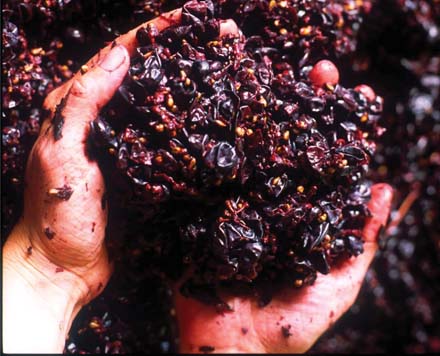 New academic research indicates that much of the conventional wisdom about seed tannins versus grapeskin tannins is misleading.
New academic research indicates that much of the conventional wisdom about seed tannins versus grapeskin tannins is misleading.In the world of theoretical physics, there is something called the Standard Model, which pulls together several key building blocks of how scientists understand the basic particles and forces that make up the universe. In winemaking, there is another kind of Standard Model for describing the role and evolution of tannins, which goes something like this:
READ MORE »Inquiring Winemaker
September 2009Varieties, Methods For Making Rosé
A rosé is a rosé is a rosé--except in the European Union, where the authorities have decided that rosé made by blending surplus red and white wine is a no-no.READ MORE »Inquiring Winemaker
August 2009The Sweet Smell of...Sugar?
Aromatic wines often arrive with some amount of residual sugar--from off-dry to sticky. But does the sugar have anything to do with the aromatics?
READ MORE »Inquiring Winemaker
July 2009Godawful Wines Made in the Vineyard
Great wines, we are told over and over, are made in the vineyard, and there's a lot of truth to that mantra. But some really crappy, problematic wines are made in the vineyard, too--a phenomenon that doesn't get quite as much press or marketing spin.READ MORE »Inquiring Winemaker
June 2009Cold Soak Purists Reveal Reasoning
If you need further proof that the conceptual apparatus surrounding winemaking isn't quite as tightly constructed as, say, the theories behind rocket science or brain surgery, look no farther than the cold soak.
READ MORE »Inquiring Winemaker
May 2009Judges on Trial
Since Wines & Vines is a media co-sponsor of the annual San Francisco Chronicle Wine Competition, I had a chance back in January to serve as one of the judges for that three - and - a - half - day marathon event at the Cloverdale Citrus Fairgrounds. I've done many smaller judgings, been to some outrageously big tastings and, of course, consumed my fair share of wine--but nothing quite like 4,700-plus wines, 1,800 different brands, 60 judges and half a week's worth of nonstop sipping and spitting.READ MORE »Inquiring Winemaker
April 2009Yeast Genetics Without GMOs
What better time than the 200th anniversary of Darwin's birth to speculate about the evolution of yeast? For almost a decade, a debate has alternately aged and simmered, in the wine world and more broadly, about the pros and cons of genetic engineering, especially when applied to things people put in their mouths. By now, the warring sides are pretty well fossilized: You're likely to be for it or agin' it. One position says the technology holds incredible promise, an unprecedented capacity to confront vineyard diseases and make wines in a whole new way, and in any case, breeding has been part of agriculture forever. The other team draws a sharp line between classical breeding and GMOs (genetically modified organisms): Nature never tried inserting a flounder gene in a tomato to help shelf life, as one now-defunct vegetable producer once attempted. Down that road, critics assert, lie Frankenfoods and Frankenwines.
READ MORE »Inquiring Winemaker
March 2009Weighing the Term 'Balance'
As I write this, I'm freshly back from judging at the San Francisco Chronicle Wine Competition, at which the 60 or so judges ripping through 4,763 wines over four days made liberal use of the word "balance" (or the alleged lack of it) as a prized descriptor. But what exactly does balance mean? Is it an objective descriptor, like "high acidity," or is it inevitably a subjective judgment, more like "delicious?"READ MORE »Inquiring Winemaker
February 2009DAP: Easy Does It
If an award were ever given for too much of a good thing in winemaking, it would surely go to DAP.READ MORE »Inquiring Winemaker
December 2008Winemakers Heated About Fermentation
I got interested in the issue of red wine fermentation temperature a few months back during a casual conversation with Julie Lumgair, winemaker at Windsor Oaks Vineyards in California's Russian River Valley. She mentioned a preference for keeping the peak temperature for most reds down to or even under 80ºF, claiming that it improved the aromatics. That seemed a bit under the orthodox 85ºF target in the textbooks, and a world apart from the 100ºF super-extractions some winemakers boast about.READ MORE »Inquiring Winemaker
November 2008Double-Edged Volatile Sulfur Compounds
I did a column a couple months back ("Winemakers Play With Fire--and Win," September 2008) about intentionally edgy winemaking--slowing fermentations down almost to the sticking point, exposing wine to overdoses of oxygen, and so on. Maybe it's because I'm neck deep in my own garage fermentations as I write this, but I'm still preoccupied with that narrow band of winemaking styles between the classically clean and the completely out-of-control.READ MORE »Inquiring Winemaker
October 2008If Filtration 'Strips' Wine, What's Getting Stripped?
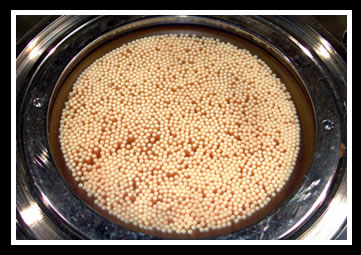 Most compounds affecting aroma, flavor, color and mouthfeel are small enough to to pass a sterile filtration membrane element (above) unchallenged.Recently I received an e-mail from Hamlet, winemaker for Prince of Denmark Vineyards. Hamlet wrote to address the question of filtration:READ MORE »
Most compounds affecting aroma, flavor, color and mouthfeel are small enough to to pass a sterile filtration membrane element (above) unchallenged.Recently I received an e-mail from Hamlet, winemaker for Prince of Denmark Vineyards. Hamlet wrote to address the question of filtration:READ MORE »Inquiring Winemaker
September 2008Winemakers Play With Fire -- and Win
In the world of software development, where I spent many years, programmers confronted by an apparent bug in their code have been known to respond, "No, that's not a bug, it's a feature." This defense rarely works. But in the world of winemaking, there really are gray areas in which rules are made to be broken, where one winemaker's faults are another's complexities, and where "a little bit pregnant" isn't an oxymoron.READ MORE »Inquiring Winemaker
August 2008Winemakers' Views On Why Wines Age
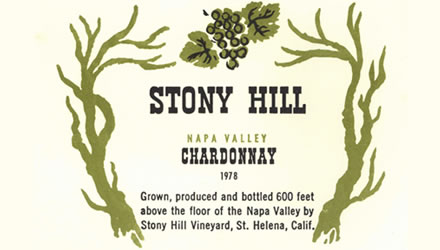 Although winemaker Peter McCrea of Stony Hill claims not to know what makes certain wines age well, the winery's Napa Valley Chardonnay is known to be drinkable for up to 30 to 40 years.As every enology graduate knows, there's science, and then there's winemaking.READ MORE »
Although winemaker Peter McCrea of Stony Hill claims not to know what makes certain wines age well, the winery's Napa Valley Chardonnay is known to be drinkable for up to 30 to 40 years.As every enology graduate knows, there's science, and then there's winemaking.READ MORE »Inquiring Winemaker
July 2008What Really Makes Wine Age Well?
One of wine's most magical properties is its ability, unique among foodstuffs, to not only survive but improve with long-term aging. A good cheese may benefit from a year or two of affinage, but only after a decade or two (or three or four) does the full wonder of a fine wine emerge--if, that is, it hasn't completely fallen apart in the meantime.READ MORE »Inquiring Winemaker
June 2008Multiplying Malolactics
How much do malolactic bacteria strains matter? And while we're at it, how about the timing of inoculation and the method of adding a starter culture? On a scale of one to 10, how much should a winemaker worry about all this?READ MORE »Inquiring Winemaker
May 2008Biodynamics In the Cellar
 The opinions of early Biodynamics influences--Rudolf Steiner, creator of the movement, Johann Wolfgang von Goethe and Hippocrates (from left)--were in sharp opposition to those of René Descartes (right), who saw the Earth as being comprised of many systems unrelated to each other.By now, everyone who follows wine closely has at least a superficial acquaintance with Biodynamic viticulture--whatever they may think about it. I would guess that in the last five years there have been more articles mentioning the idea of burying a cow horn full of dung than articles about many standard vineyard practices. But after the grapes are harvested, and once they're in the cellar, what is the Biodynamic way? Is there such a thing as Biodynamic winemaking, or is it just Biodynamic grapegrowing?READ MORE »
The opinions of early Biodynamics influences--Rudolf Steiner, creator of the movement, Johann Wolfgang von Goethe and Hippocrates (from left)--were in sharp opposition to those of René Descartes (right), who saw the Earth as being comprised of many systems unrelated to each other.By now, everyone who follows wine closely has at least a superficial acquaintance with Biodynamic viticulture--whatever they may think about it. I would guess that in the last five years there have been more articles mentioning the idea of burying a cow horn full of dung than articles about many standard vineyard practices. But after the grapes are harvested, and once they're in the cellar, what is the Biodynamic way? Is there such a thing as Biodynamic winemaking, or is it just Biodynamic grapegrowing?READ MORE »Inquiring Winemaker
April 2008Going Wild In the Cellar
What's in it? Where will it go? Fermenting with wild yeast can be risky business, but for many daring winemakers, it's a risk worth taking.Some winemakers get their inspiration about yeast choices from product catalogs, some from experimental results reported in enology journals, some from mimicking successful producers in other countries. A few brave souls take their cues from Maurice Sendak's children's classic, Where the Wild Things Are.READ MORE »Inquiring Winemaker
March 2008Anyone Remember GWSS?
Ten years ago, the unwelcome entrance of this xylem-sucking pest into Southern California vineyards set off every alarm bell in the industry. The Temecula Valley wine country in Riverside County, especially hard-hit by the epidemic of Pierce's disease (PD) that the sharpshooter was so good at spreading, was widely assumed to be terminal, and the vastly more valuable stretches of vineyard land up North went onto a death-watch.READ MORE »Inquiring Winemaker
February 2008'Food-Friendly' Winemaking
Wine That Loves names its wines for popular American foods to make pairing a no-brainer.Food and wine matching verges on a national obsession in the United States. A sizable industry has grown up to support and evangelize for the pleasures of pairing: wine education seminars, newspaper and magazine columns, helpful menu annotations at restaurants. The International Association of Culinary Professionals bestowed its Best Book of the Year award this past April on What To Drink With What You Eat, by Andrew Dornenburg and Karen Page, the heart of which is a couple hundred pages of small-type matchmaking suggestions for thousands of dishes.READ MORE »Inquiring Winemaker
January 2008Residual Sugar-- 'How Sweet It Is'
Several decades back, before most of you could drink wine legally, before half of you were born, comedian Jackie Gleason built a career around the catchphrase, "How sweet it is," (revived for the title of his 1966 album, released by Columbia Records, at right) a pithy celebration of someone else's bad fortune. Now if that's too dated, maybe you remember James Taylor singing the same words, in a decidedly more upbeat vein, savoring how lucky he was "to be loved by you." But these days, when the wine world talks about high-end, New World reds, the phrase morphs into a question: "How sweet is it?"READ MORE »Inquiring Winemaker
January 2008Power of Technology
Some of the most important technology in the world of wine never makes an appearance at trade shows. Automated tanks, newfangled presses and mechanical pruning equipment that treats grapevines like mothers treat babies are marvelous to behold, but there are things hidden away in research labs and on computer hard drives that are equally astonishing, and likely to have greater impact in the long run.READ MORE »Inquiring Winemaker
December 2007Whatever Happened to Fat, Oaky Chardonnay?
No wine has done as much to build up the California wine industry--and no wine has gotten as much grief for it--as Chardonnay.READ MORE »Inquiring Winemaker
November 2007Wineries Rely on VA Removal
Things winemakers hate to talk about, but can't live without, Chapter 27: removing VA from wine.READ MORE »Inquiring Winemaker
October 2007The 'Natural' Trap
Supermarket shelves these days bulge with products claiming to be "natural"--everything from breakfast cereals to canned beans to frozen dinners. Most of us take these claims with a heaping pinch of skepticism. The wine aisle trumpets the same message, reinforced by a mountain of press packets and website rhapsodies about how "our wines are made in the vineyard." The image is surely in line with the times, but it may not be all that well-considered.READ MORE »Inquiring Winemaker
September 2007Is Yeast Boosting Alcohol Levels?
There's a long string of factors involved in the rising tide of high-alcohol wines--but yeast isn't one of them. It's not hard to find winemakers who will tell you that among the things ratcheting up the ethanol levels these days is the tendency of current-release commercial yeast strains to be more efficient at converting sugar to alcohol--more bang for the Brix. Nobody claims that's the whole story, but this theory shows up on just about every list.READ MORE »Inquiring Winemaker
August 2007When to Use Alcohol Reduction
Vinovation, Inc., pioneered the reverse osmosis process, which uses membrane filtration to remove excess alcohol from wine.In response to the growing chorus of complaints from critics and consumers alike about rising alcohol levels and unbalanced wines, I'm pleased to report that somebody's doing something about it-the folks at Vinovation, Inc., and ConeTech, with their science-fictiony techniques for removing alcohol from finished wine.READ MORE »Inquiring Winemaker
June 2007Mysteries of Extended Maceration
Extended maceration--leaving wine on the skins for as long as three or four weeks after the end of fermentation--is:READ MORE »Inquiring Winemaker
April 2007More on Toothsome Tannin Terms
Last time around in this space, I tried to parse through the terminology of "hard" and "soft" tannin, surveying the different things people mean by this dichotomous pair of words and asking how well the common usage matches up with verifiable research data. (Hint: not very well.) This time, let's see what we can tease out of "green" versus "ripe" tannin, the harvest time precursors of hard and soft.READ MORE »Inquiring Winemaker
February 2007Toothsome Tannin Terms--Part I
Getting a handle on wine and grape tannin is hard work, but the area is ripe for study, since winemakers who can tease out the soft ones make their colleagues green with envy.READ MORE »Inquiring Winemaker
December 2006Myths of Minerality
Fruit and oak have their place in great wine, but the top prize among wine attributes probably goes to minerality--the expression of rocks and soil in the aromas and flavors that end up in the glass. But for all its desirability and status, minerality is only vaguely defined and not well understood. In fact, the one thing we do know is that it has very little to do with minerals.READ MORE »Inquiring Winemaker
October 2006Riesling Really Is Made in the Vineyard
Some time ago, a friend shipped me a mixed case of Rieslings from the Finger Lakes region of upstate New York. (This was back in the Dark Ages, when shipping wine from New York meant handing it over to a freight hauler, waiting several weeks, and paying as much for the transit as the wines.) They were all delightful, and I couldn't stop wondering: How do they do that?READ MORE »Inquiring Winemaker
August 2006How Syrah Left Sangiovese In The Dust
In the mid-1980s, Jim and Suzy Gullett were among the would-be California winemakers looking around for alternative grapes that might be the next new thing. "You'll find this amusing," Jim says, "but we were originally thinking about Rhône varieties. We had appointments set up in France with Guigal. Then I decided that Amador County's Shenandoah Valley was too hot for Syrah, so we went to Italy instead."READ MORE »Inquiring Winemaker
June 2006Beyond Bulk
The wine business thrives on terminology that carries a built-in electrical charge; that's why press releases are sprinkled with buzz words like "single vineyard," "unfined and unfiltered" or even "open-top fermenter." "Bulk wine" is not one of those fortunate phrases. "Bulk wine" has all the magnetism of "processed cheese product."READ MORE »Inquiring Winemaker
April 2006The Tannin Addition Bandwagon
Judging from the recent rise in popularity of tannin additions in California winemaking, you could be excused for thinking grapes from the Golden State must not contain any tannins of their own. And you might be tempted to feel sorry for the poor souls who made wine for nearly 7,000 years without benefit of these apparently indispensable aids.READ MORE »Inquiring Winemaker
February 2006Making Pinot Noir
Is Pinot Noir really all that hard a wine to make? Or is it just that Pinot producers whine more than other winemakers?READ MORE »CURRENT COLUMN ARTICLES »

